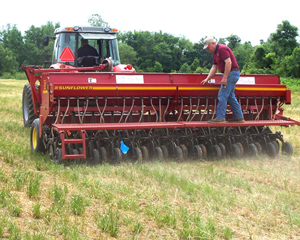 Some farmers in Tennessee are testing out the first switchgrass seed varieties specifically developed for biofuels production.
Some farmers in Tennessee are testing out the first switchgrass seed varieties specifically developed for biofuels production.
Their goal is to learn first-hand how to manage this new crop, and then use that knowledge to facilitate the development of the bioenergy industry in Tennessee. Tennessee growers Tony and Tim Brannon – pictured here getting some planting done last week – are part of the 25Farmer Network, a group evaluating the potential of alternative crops in western Tennessee organized by the Memphis Bioworks Foundation.
 Energy crop company Ceres is developing many of the varieties being tested. Company officials believe switchgrass can produce substantially more biomass and higher yields than many believe.
Energy crop company Ceres is developing many of the varieties being tested. Company officials believe switchgrass can produce substantially more biomass and higher yields than many believe.
The company reports results from national field trials have shown average biomass yields among switchgrass seed varieties tested last season were as much as 50% more than the government’s projected yields for 2022. The highest yield was reported in California, where a Ceres experimental variety produced 19 tons per acre. Ceres switchgrass product manager Cory Christensen says this result “demonstrates the genetic potential of switchgrass grown under favorable conditions” and he predicts that they will continue to increase average yields in the future.

